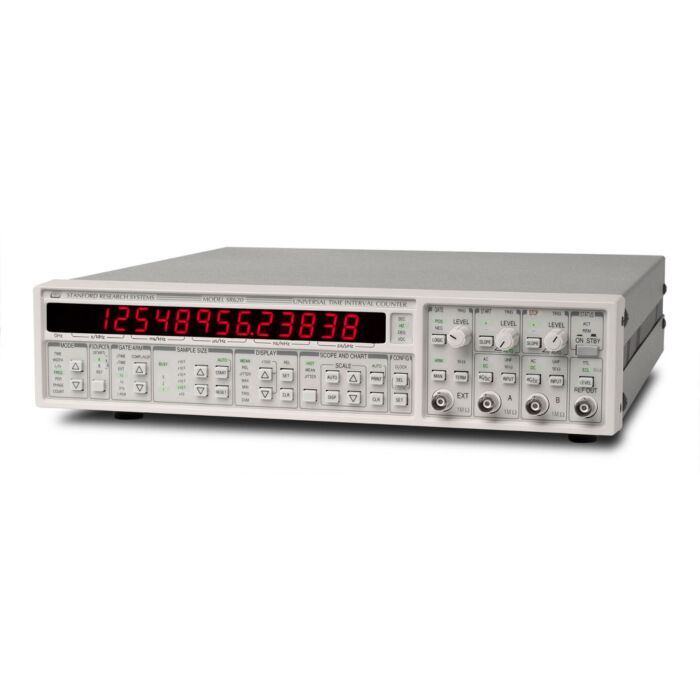Product Highlights
- 25 ps single-shot resolution
- 1.3 GHz frequency range
- 11-digit freq. resolution (1s)
- Statistics & Allan variance
- Graphical output to XY scopes
- GPIB and RS-232 interfaces
- Ovenized timebase (opt.)
The SR620 Time Interval Counter performs virtually all of the time and frequency measurements required in a laboratory or ATE environment. The instrument's single-shot timing resolution and low jitter make it the counter of choice for almost any application.
SR620 Measurements
The SR620 measures time interval, frequency, pulse-width, rise and fall time, period, phase and events. Time intervals are measured with 25 ps rms resolution, making the SR620 one of the highest resolution counters available. Frequency is measured from 0.001 Hz to 1.3 GHz, and a choice of gates ranging from 1 period to 500 seconds is provided. The SR620 delivers up to 11 digits of frequency resolution in one second, making it suitable for measurement applications ranging from short-term phase locked loop jitter, to the long-term drift of atomic clocks. All measurement modes are supported by a wide variety of flexible arming and triggering options.
Histograms and Strip Charts
Unlike conventional counters that only have numeric displays, the SR620 provides live, graphical displays of measurement results. Graphical data is available in three formats: a histogram showing the distribution of values within a set of measurements, a strip chart of mean values from successive measurements, or a strip-chart of jitter (standard deviation or Allan variance) values from successive measurements. Up to 250 strip-chart points, or histogram bins, can be displayed.
Both histograms and strip charts can be displayed on any oscilloscope with an X-axis input (see pictures), or can be plotted on an HP-GL compatible plotter or dot-matrix printer. Convenient cursors allow you to read the value of any data point in the histogram or strip chart. Autoscale and zoom features make it simple to display all, or any portion, of the graphs.
Statistics
The SR620 can make measurements on a single-shot basis, or calculate the statistics of a set of measurements. Sample sizes from one to one million can be selected. The SR620 will automatically calculate the mean, standard deviation or Allan variance, minimum and maximum for each set of measurements.
Reference Output
A precision 50 % duty cycle square wave (1 kHz) is available at the front-panel REF output. The REF output can be used as a source of start or stop pulses for any of the SR620's measurement modes. For instance, the length of a cable connected between REF and the B input can be precisely determined by measuring the time delay between REF and B.
DVMs and Analog Outputs
Two rear-panel DVM inputs make measurements of DC voltages with 0.3 % accuracy (±20 VDC range). These values may be read via the interfaces or displayed directly on the front panel.
Two DAC outputs continuously provide voltages proportional to the mean and the jitter of the measurement sample. These 0 to 10 V outputs can drive strip chart recorders, or they can be set to provide fixed or scanned output voltages.
Built-In Auto-Calibration
A sophisticated, built-in auto-calibration routine nulls insertion delays between start and stop channels, and compensates for the differential nonlinearities inherent in analog time-measurement circuitry. The auto-calibration routine takes about two minutes to perform, and should be run every 1000 hours of operation.
10 MHz Reference
The choice of timebase affects both the resolution and accuracy of measurements made with the SR620. SRS offers a choice of a standard timebase with an aging coefficient of 1 x 10-6/year, or an optional ovenized-oscillator timebase with only 5 x 10-10/day aging, and about an order of magnitude better short-term stability than the standard timebase. A rear-panel input lets you connect any external 5 MHz or 10 MHz source as a timebase.
Computer Interfaces
Standard GPIB (IEEE-488.2) and RS-232 interfaces allow remote control of the SR620. All instrument functions and configuration menu settings are accessible via the interfaces. A fast binary dump mode outputs up to 1400 measurements per second to a computer. A parallel printer port allows direct printing from the instrument. Standard IEEE-488.2 communications are supported, and plotter outputs are provided in HP-GL format. For convenient debugging, the last 256 characters transmitted over the interfaces can be viewed on the front panel.



